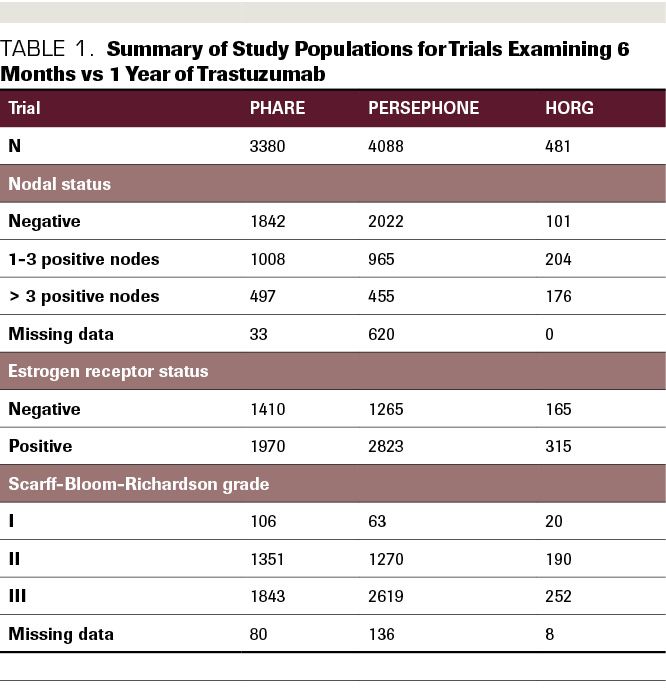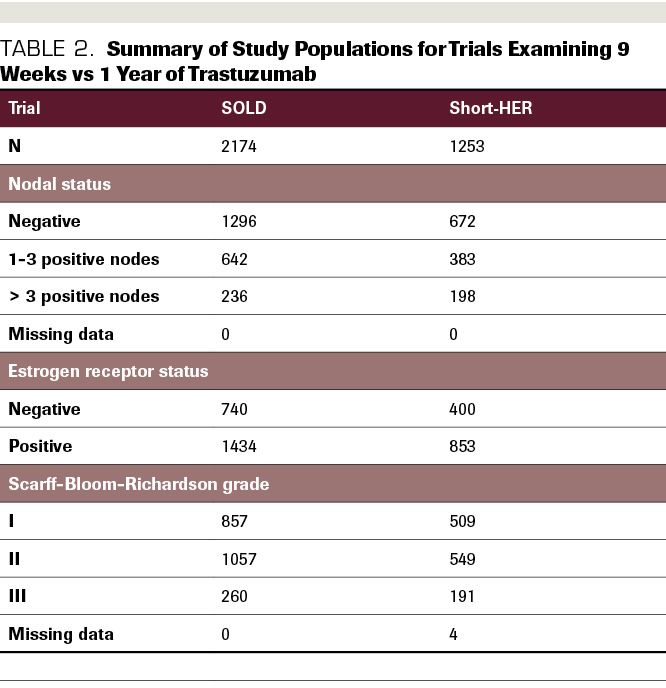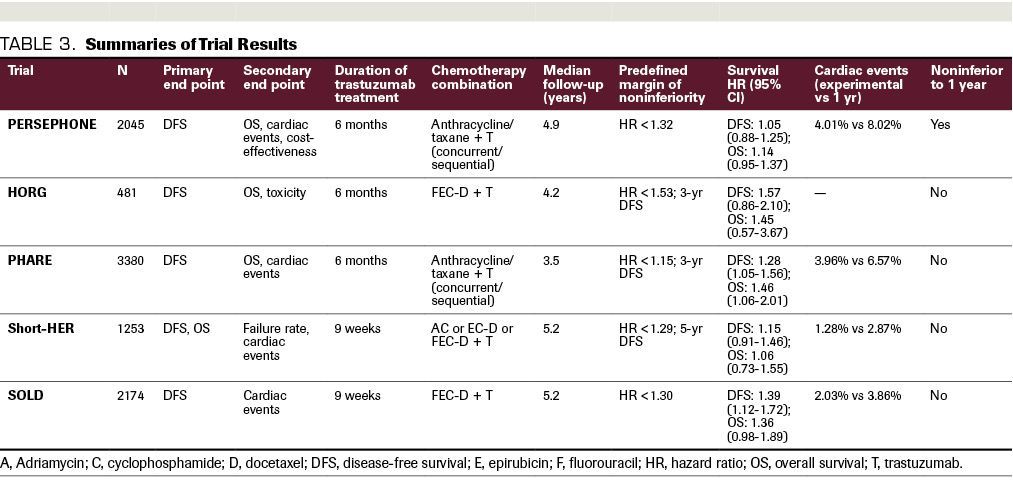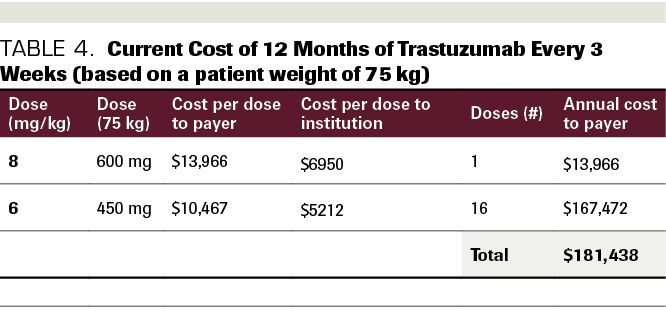Optimizing the Duration of Trastuzumab: A Fresh Perspective
ABSTRACT Prior to the introduction of trastuzumab, the first targeted anti-HER2 agent, in 1998, patients diagnosed with HER2-positive breast cancer felt like they were being handed a death sentence. Despite treatment with aggressive chemotherapy, their tumors recurred faster, more often spread to brain and liver, and were associated with higher rates of death than HER2-negative tumors. However, in the 1980s, cancer researchers and oncologists recognized that HER2 could be targeted by a small molecule that binds to the receptor on the cell surface and blocks the signal telling the cell to divide. This small molecule was called trastuzumab, and it eventually completely changed how HER2-positive breast cancer was treated. The drug was first approved in the metastatic setting, and then the results of 2 pivotal randomized control trials demonstrated that the administration of trastuzumab in the adjuvant setting decreased the risk of breast cancer recurrence by 50%. These trials showed trastuzumab to be unequivocally effective in the adjuvant setting and the HERA trial results led to the adoption of 1 year of adjuvant trastuzumab as the standard of care. Since that time, the field of anti–HER2-targeted therapy has exploded, with the development of multiple targeted agents for use in the advanced and up-front settings. Although trastuzumab significantly improves outcomes for women diagnosed with HER2-positive breast cancer and has few adverse effects (AEs), the disadvantages are that it requires intravenous administration every 3 weeks and can be associated with cardiac AEs. It is also expensive. Given all of these factors, the question of whether a duration of trastuzumab that is shorter than 1 year may be acceptable for some patients with early-stage HER2-positive breast cancer is an important and very relevant one. Here, we will review the studies that have examined this question and evaluate their results.
is a medical oncologist at the Winship Cancer Institute and assistant professor in the Department of Hematology and Medical Oncology at Emory University School of Medicine.

is a clinical pharmacy specialist in medical oncology at Winship Cancer Institute and Emory University School of Medicine.

Department of Medicine, Emory University School of Medicine.

Introduction
Prior to the introduction of trastuzumab, the first targeted anti-HER2 agent, in 1998, patients diagnosed with HER2-positive breast cancer felt like they were being handed a death sentence. Despite treatment with aggressive chemotherapy, their tumors recurred faster, more often spread to brain and liver, and were associated with higher rates of death than HER2-negative tumors.1 HER2-positive breast cancer was also more prevalent in younger patients, making the diagnosis even more devastating.2 However, in the 1980s, cancer researcher Axel Ullrich, PhD, and oncologist Dennis Slamon, MD, PhD, recognized that HER2 could be targeted by a small molecule that binds to the receptor on the cell surface and blocks the signal telling the cell to divide.3 This small molecule was called trastuzumab, and it eventually completely changed how HER2-positive breast cancer was treated.
The availability of trastuzumab gave much-needed hope to patients diagnosed with this aggressive form of breast cancer. The drug was first approved in the metastatic setting, and then the results of 2 pivotal randomized control trials in 20054-5 demonstrated that the administration of trastuzumab in the adjuvant setting decreased the risk of breast cancer recurrence by 50%, leading to its approval in 2006 by the FDA for use as adjuvant therapy for early-stage HER2-positive breast cancer.6 These trials showed trastuzumab to be unequivocally effective in the adjuvant setting; however, the optimal duration of treatment was still unknown.
The HERA trial was designed to address the question of adjuvant trastuzumab duration, randomizing patients 1:1:1 to receive 1 year of adjuvant trastuzumab, 2 years of adjuvant trastuzumab, or no adjuvant trastuzumab; then, important disease-related outcomes were compared among groups.7 Investigators demonstrated statistically significant improvement in 2-year disease-free survival (DFS) in patients treated with 1 and 2 years of adjuvant trastuzumab compared with patients who received no trastuzumab; however, there was no difference in outcomes for 1 year vs 2 years of trastuzumab. HERA’s results led to the adoption of 1 year of adjuvant trastuzumab as the standard of care.
Since that time, the field of anti–HER2-targeted therapy has exploded, with the development of multiple targeted agents for use in the advanced and up-front settings. We also have a wealth of options in addition to adjuvant trastuzumab for our patients with the highest-risk early-stage disease. APHINITY (NCT01358877) established the benefit of the addition of a year of adjuvant trastuzumab/pertuzumab for patients with node-positive disease.8 The KATHERINE trial (NCT01772472) established the benefit of switching to adjuvant ado-trastuzumab emtansine (T-DM1; Kadcyla) rather than continuing trastuzumab if a pathological complete response is not achieved with neoadjuvant anti–HER2 therapy (albeit with more toxicity than adjuvant trastuzmab).9 In addition to these options for intensifying therapy, there are also new regimens to allow for less intense therapy for patients with lower-risk (mostly node-negative) disease.10 But even for these patients, a year of trastuzumab has remained the standard of care after chemotherapy and local therapy (surgery +/– radiation) is finished.
Although trastuzumab significantly improves outcomes for women diagnosed with HER2-positive breast cancer and has few adverse effects (AEs), the disadvantages are that it requires intravenous administration every 3 weeks and can be associated with cardiac AEs. It is also expensive. Because of this, many patients suffer financial toxicity from medical bills as well as from time out from work and the need to find extra child or elder care in order to come in every 3 weeks for treatment. In addition, keeping a port for an entire year can be a constant reminder of cancer for patients, which can be challenging emotionally.
Given all of these factors, the question of whether a duration of trastuzumab that is shorter than 1 year may be acceptable for some patients with early-stage HER2-positive breast cancer is an important and very relevant one. Here, we will review the studies that have examined this question and evaluate their results.
Examining the Evidence: 1 Year of Trastuzumab vs a Shorter Duration
In 2009, the results of the FinHer trial demonstrated that women treated with fluorouracil, epirubicin, and cyclophosphamide (FEC) and docetaxel, and a 9-week course of trastuzumab, had an improvement in distant DFS of 11.7% at 3 years compared with docetaxel and FEC without trastuzumab (HR, 0.32; P = .029).11 This result was remarkably similar to the joint analysis of the two 2005 studies that showed an improvement in DFS of 11.8% at 3 years.4-5 FinHer(ISRCTN 76560285) was the first trial to show that a shorter duration of treatment might be just as effective as the standard-of-care 12-month duration. Inspired by FinHer’s promising results, a number of additional clinical trials were designed to answer this specific question.
The PHARE trial (NCT00381901) was a phase 3, open-label trial in France that randomized 3380 women with early-stage HER2-positive breast cancer to either 6 months or 12 months of adjuvant trastuzumab. The primary outcome was noninferiority of DFS in the 6-month group, with a predefined noninferiority margin of 1.15. The results showed DFS events in 20.4% of the 12-month group compared with 21.2% in the 6-month group. The hazard ratio (HR) of 1.08 (95% CI, 0.93-1.25) included the noninferiority margin, thus the trial did not show noninferiority. However, the overall survival (OS) estimates were similar: The 12-month group had a survival estimate of 86.2% at 5 years compared with 84.2% in the 6-month group. At 7 years, the survival estimate for the 12-month group was 82.3% compared with 80.6% for the 6-month group.12
The HORG trial ( NCT00712140) was a randomized, controlled noninferiority trial conducted in Greece that also compared 6 months of adjuvant trastuzumab with the standard 12-month duration of therapy in 481 women with early-stage HER2-positive breast cancer. The primary end point was DFS at 3 years. The results demonstrated a 3-year DFS rate of 95.7% in the 12-month group and 93.3% in the 6-month group, representing a difference of 2.4% and no statistically significant difference in OS (HR, 1.57; 95% CI, 0.86-2.10; P = .137).13 Like the PHARE trial, the HORG trial also failed to show noninferiority for the 6-month group; however, both groups still demonstrated very promising 3-year DFS rates.
The PERSEPHONE trial (NCT00712140) took place in the United Kingdom and included 2045 patients with early-stage breast cancer with a noninferiority limit HR set at 1.32. This study demonstrated a 4-year DFS of 89.4% and 89.8% in the 6-month and 12-month groups, respectively, with a HR of 1.07 (90% CI, 0.93-1.24; P = .011). This study did show noninferiority of 6 months of trastuzumab compared with 12 months. OS at 4 years was also statistically noninferior, at 94.8% in the 12-month group and 93.8% in the 6-month group with a HR of 1.14 (90% CI, 0.95-1.37; P = .0010).14 The overall numerical results were very similar to those of the PHARE trial, but the slightly larger noninferiority margin between PERSPEHONE and PHARE determined the differences in the final conclusions between the 2 studies. (Table 1)
Table 1. Summary of Study Populations for Trials Examining 6 months vs 1 year of Trastuzumab

Two trials examined noninferiority of 9 weeks of trastuzumab compared with 12 months: Short-HER (NCT00629278) and SOLD (NCT00593697). These studies used the promising results of the FinHer trial with 9 weeks of trastuzumab therapy as the experimental group. The Short-HER trial consisted of 1254 patients with early-stage breast cancer and used a noninferiority margin of HR less than 1.29. The 5-year DFS was 88% in the 12-month group and 85% in the 9-week group, with an HR of 1.13 (90% CI, 0.89-1.42). The 5-year OS was 95.2% in the 12-month group and 95.0% in the 9-week group.15 The SOLD trial included 2174 women, and the results did not demonstrate noninferiority, with a 5-year DFS of 88.0% in the 9-week group and of 90.5% in the 12-month group (HR,1.35; 90% CI, 1.12-1.72). The 5-year OS did not differ significantly between groups: 94.7% vs 95.9% in the 9-week and 12-month groups, respectively (HR,1.36 90% CI, 0.98-1.89).16(Table 2)
Table 2. Summary of Study Populations for Trials Examining 9 Weeks vs 1 year of Trastuzumab

Of these 5 trials, only PERSPEHONE’s results showed noninferiority. In a meta-analysis of the 5 trials, there was a statistically significant difference in the DFS and OS between the shorter duration of treatment—both 9 weeks and 6 months, pooled—compared with the 12-month duration of treatment, with a HR of 1.21 (95% CI, 1.08-1.37) for DFS and an HR of 1.31 (95% CI, 1.08-1.59) for OS. However, these differences were not statistically significant for lower-risk patients with node-negative disease (HR, 1.20; P = .11) and estrogen receptor (ER)-positive disease (HR, 1.15; P = .09).17 A meta-analysis of the HORG, PERSEPHONE, and PHARE trials more closely examined ER status as an effect modifier on trastuzumab duration. Patients with ER-negative disease had a statistically significant improvement in DFS with the 12-month duration of treatment (HR,1.39; 95% CI, 1.14-1.70). Patients with ER-positive disease did not have a statistically significant difference in DFS between the 6-month and the 12-month durations of therapy (HR,1.10 95% CI, 0.90-1.34), indicating that a shorter course of therapy may be acceptable in this patient population.18
Risks and Benefits
Shared decision-making and patient-reported outcomes (PROs) are becoming more important in today’s health care system, and especially in breast cancer treatment. A study by Simes et al looked at what patients believed to be an acceptable survival benefit to warrant making the decision to undergo adjuvant chemotherapy for early-stage breast cancer. The authors found that more than 70% of patients justified treatment for a 5% or greater improvement in OS at 5 years. Factors that were found to be important in determining patient preferences included support required by patients’ dependents, support system, and treatment-related toxicities.19 Another study by Tevis et al looked at the benefits and challenges of incorporating PROs into clinical trials. The study recognized that PROs “provide information to support patients in shared decision-making, serve as a measurement of patient-centered care, allow hospitals to monitor outcomes of care over time, play a role in value-based payments, and identify targets for quality improvement efforts.” Common metrics to measure PROs include survival and disease control, degree of recovery and functional status, access to treatment, treatment-related complications, health-related quality of life, and long-term consequences of therapy.20
It is important to consider these PROs and preferences in context of the limited absolute benefit seen with shorter vs longer courses of trastuzumab, particularly for ER-positive, node-negative patients. Additionally, given the recent coronavirus disease 2019 (COVID-19) pandemic, it is important to consider the risk that frequent contact with the health care system poses for patients being treated for breast cancer. Cancer patients are reported to have a high risk of complications and death from COVID-19,21 and it is important to minimize their risk of exposure while still providing adequate treatment.
Special Considerations: the COVID-19 Pandemic
A recent study by Kuderer et al published in The Lancet examined the outcomes of a cohort of cancer patients with COVID-19 across the United States, Canada, and Spain, and found that, compared with patients without cancer who contracted COVID-19, patients with cancer and COVID-19 had a higher associated 30-day all-cause mortality; this was especially true of patients with increased age (odds ratio [OR], 1.84; 95% CI, 1.52-2.10), ≥2 comorbidities (OR, 4.5; 95% CI, 1.33-15.28), and active cancer (OR, 5.20; 95% CI, 2.77-9.77). Breast cancer represented the most common type of malignancy in the study, affecting 21% of patients.22 Another study examining patients hospitalized due to COVID-19 in China’s Huebi province compared 105 patients with cancer and 536 patients without cancer; the results indicated that those with cancer had a higher death rate (OR, 2.34; 95% CI, 1.15-4.77).23
In response to the increased burden on the health care system during the COVID-19 pandemic and the recognition that cancer patients represent a high-risk population, breast cancer organizations implemented guidelines for treatment to minimize the risk of contracting COVID-19. The COVID-19 Breast Cancer Consortium included representatives from the American Society of Breast Surgeons, the National Accreditation Program for Breast Centers, the National Comprehensive Care Network, the Commission on Cancer, and the American College of Radiology, and its recommendations state that it is acceptable to consider reducing the duration of trastuzumab therapy to 6 months due to the “substantial survival benefit and the absence of data suggesting any detrimental defect of use during the pandemic.”24 Similarly, the guidelines released by the European Society for Medical Oncology recommend that “for selected HER2-positive breast cancer, low-risk or elderly patients with cardiovascular or other comorbidities, adjuvant anti-HER2 therapy may reasonably be discontinued after 6 months instead of 12 months.”25 Italy released recommendations that were adopted during the COVID-19 outbreak in a study published in The Oncologist, which discussed the strategies used at the beginning of the outbreak to ensure best possible care while mitigating the risk of infection using a personalized risk-benefit ratio. For patients who were determined to be at “high risk” of infection—of older age and with comorbidities—it was also recommended to consider shortening duration of trastuzumab therapy to 6 months.26 In the span of a few weeks, health care systems were challenged to transform how cancer care is delivered in the setting of a pandemic. While it will be essential to resume certain care practices during the recovery phase, there may be closer consideration of changes that were found to be beneficial to patient care, such as reduced duration of trastuzumab therapy.
Cardiotoxicity
Trastuzumab has been shown to have potential cardiac-related AEs. In all 5 studies included in Table 3, the patients received baseline echocardiograms, and women with preexisting cardiac disease were excluded. Cardiac events in the PHARE and the PERSEPHONE trial were analyzed separately. In the PHARE trial, 5.9% of patients in the 12-month group and 3.4% of patients in the 6-month group experienced New York Heart Association Class I or II cardiac dysfunction during therapy with trastuzumab.27 In the PERSEPHONE trial, there was significantly more clinical cardiac toxicity in the 12-month group compared with the 6-month group (13% vs 10%; P = .04), and twice as many 12-month as 6-month patients stopped early because of cardiac events (8% vs 4%; P <.0001). In the 12-month group, 8% of patients had a decrease in left ventricular ejection fraction (LVEF) to <50% compared with 6% in the 6-month group (P = .004), which suggests a longer period of cardiac stress and slower recovery. Age was shown to be an independent risk factor, with patients aged >70 years having an OR for cardiac dysfunction of 2.72. Patients with a lower LVEF at baseline (between 50% and 55%) had an OR of 5.22 for developing cardiac dysfunction.28 In any study, it is important to consider generalizability of the study population. Initial exclusion criteria in the PHARE trial included patients who had previous medical conditions prohibiting the use of trastuzumab, such as documented congestive heart failure, arrythmias, angina pectoris, severe dyspnea at rest, and oxygen dependency. Patients who would have a difficult time with follow-up, and patients who could not have regular controls from social, geographic, or psychological reasons were also excluded.12 Many patients with early-stage breast cancer also have 1 or more of these risk factors and/or meet these exclusion criteria, and for them, a shorter duration of treatment of trastuzumab may be more appropriate than the standard duration.
Table 3. Summaries of Trial Results

Financial Toxicity
With the exponentially rising cost of health care in today’s practice environment, it is important to consider the cost-effectiveness of treatment when considering 2 different treatment durations. At the time the PERSEPHONE trial was published, the average costs for patients in the 6-month and 12-month arms were 2538.64 British pounds (~US$3299.4) and 12,333.83 British pounds (~US$16,033.98), respectively.29 Currently in the United States, the cost of treatment is much higher than at the time of the PERSEPHONE trial. The current cost of 12 months of trastuzumab every 3 weeks for a person weighing
75 kg is shown in Table 4.
Table 4. Current Cost of 12 Months of Trastuzumab Every 3 weeks (based on a patient weight of 75kg)

This cost information was obtained from average wholesale pricing and will vary by institution; however, it still allows for an estimate of the overall cost of a 12-month duration of therapy. The annual cost to the patient before insurance is $181,438 and the annual cost to the institution is $90,342. The cost differential is dramatic: an $83,736 difference between a 12-month and a 6-month duration of treatment. For patients lucky enough to have insurance that covers most of the cost, this is not an issue. For patients who have limited or no insurance, the cost of treatment could financially devastate them and their families for decades. Results of a 2018 study published in the American Journal of Medicine found that patients with cancer are 2.65 times more likely to file for bankruptcy than those without cancer, which increases their risk for death.30 The rapid advancements in breast cancer therapy often lead to more expensive treatments, higher deductibles, and more co-pays, all of which contribute to financial toxicity and ongoing anxiety around the diagnosis and treatment of breast cancer.
Emotional Costs
The cost of treatment is not the only financial toxicity affecting patients with early-stage breast cancer. There is also the issue of missing work to undergo treatment. The first infusion of trastuzumab takes around 90 minutes while the subsequent infusions take 30 minutes, but each treatment requires a visit to the infusion center for treatment, and periodically, a visit with the prescribing physician beforehand is required as well. Transportation time to these appointments and waiting room time also must be factored into the total duration of each trastuzumab treatment, which is all time a patient spends away from family, work, or other activities they enjoy. A prospective study from France looked at the impact of breast cancer treatment on employment for a cohort of 1874 women and found that at 2 years after diagnosis, 21% of patients had not returned to work. Patients treated with chemotherapy plus trastuzumab had significantly higher odds of not returning to work at 2 years (OR, 2.15; 95% CI, 1.29-3.57) compared with chemotherapy plus hormone therapy. Patients treated with chemotherapy alone also had increased odds of not returning to work (OR, 1.58; 95% CI, 1.05-2.37); however, the difference was not as significant as for chemotherapy plus trastuzumab. The study authors commented on potential reasons for the statistically significant differences in returning to work; they noted that for patients being treated with trastuzumab, specifically, those reasons can include persistent fatigue, being more likely to perceive themselves as sick for a longer time, and being overwhelmed with accumulation of treatments.31
Conclusions
Results from the individual randomized controlled trials, with the exception of the PERSEPHONE trial, and the pooled meta-analysis of all 5 trials, demonstrate that a treatment duration of 6 months or 9 weeks of trastuzumab is not statistically noninferior to a treatment duration of 12 months. However, for patients with node-negative or ER-positive disease, there was no significant difference between the longer and shorter durations of treatment. For many patients with node-negative and/or ER-positive, HER2-positive breast cancer, a shorter duration of trastuzumab would likely be sufficient, and if they have cardiac or other comorbidities, may even be safer overall. A shorter duration of trastuzumab also reduces costs to the patient and the health care system generally, reducing the overall cost of treatment by almost $100,000 per patient. Patients who would have a hard time managing a rigorous 12-month trastuzumab treatment schedule, and are in a lower-risk category, would likely have the same benefit from a shorter duration of therapy with far less emotional and financial strain. When the current COVID-19 pandemic is factored in, that pushes the needle even further in the direction of doing less rather than more when appropriate, in order to minimize exposure.
Evidence-based medicine is the backbone of the health care system, but it is critical to consider the difference between statistically significant data and clinically significant data, and to discuss the numbers as well as the realities with our patients. For many patients with early-stage HER2-positive breast cancer, a shorter course of trastuzumab may be more appropriate than a full year of treatment when taking into account financial and logistical considerations as well as their other medical conditions.
Financial Disclosure: The authors have no significant financial interest in or other relationship with the manufacturer of any product or provider of any service mentioned in this article.
REFERENCES
- Moasser MM. The oncogene HER2; its signaling and transforming functions and its role in human cancer pathogenesis. Oncogene. 2007;26(45):6469-6487. doi:10.1038/sj.onc.1210477
- Murphy BL, Day CN, Hoskin TL, et al. Adolescents and young adults with breast cancer have more aggressive disease and treatment than patients in their forties. Ann Surg Oncol. 2019;26(12):3920-3930. doi:10.1245/s10434-019-07653-9
- Slamon DJ, Clark GM, Wong SG, et al. Human breast cancer: correlation of relapse and survival with amplification of the HER-2/neu oncogene. Science. 1987;235(4785):177-182. doi:10.1126/science.3798106
- Romond EH, Perez EA, Bryant J, et al. Trastuzumab plus adjuvant chemotherapy for operable HER2-positive breast cancer. N Engl J Med. 2005;353(16):1673-1684. doi:10.1056/NEJMoa052122
- Piccart-Gebhart MJ, Procter M, Leyland-Jones B, et al; Herceptin Adjuvant (HERA) Trial Study Team. Trastuzumab after adjuvant chemotherapy in HER2-positive breast cancer. N Engl J Med. 2005;353(16):1659-1672. doi:10.1056/NEJMoa052306
- Herceptin. Prescribing information. Genentech; 2010. Accessed xx xx, 2020. https://www.accessdata.fda.gov/drugsatfda_docs/label/2010/103792s5256lbl.pdf
- Goldhirsch A, Gelber RD, Piccart-Gebhart MJ, et al; Herceptin Adjuvant (HERA) Trial Study Team. 2 yearsversus 1 year of adjuvant trastuzumab for HER2-positive breastcancer (HERA): an open-label, randomised controlled trial. Lancet. 2013;382(9897):1021-1028. doi:10.1016/S0140-6736(13)61094-6
- von Minckwitz G, Procter M, de Azambuja E, et al; APHINITY Steering Committee and Investigators. Adjuvant pertuzumab and trastuzumab in early HER2-positive breast cancer. N Engl J Med. 2017;377(2):122-131. doi:10.1056/NEJMoa1703643
- von Minckwitz G, Huang CS, Mano MS, et al; KATHERINE Investigators. Trastuzumab emtansine for residual invasive HER2-positive breast cancer. N Engl J Med. 2019;380(7):617-628. doi:10.1056/NEJMoa1814017
- Tolaney SM, Barry WT, Dang CT, et al. Adjuvant paclitaxel and trastuzumab for node-negative, HER2-positive breast cancer. N Engl J Med. 2015;372(2):134-141. doi:10.1056/NEJMoa1406281
- Joensuu H, Bono P, Kataja V, et al. Fluorouracil, epirubicin, and cyclophosphamide with either docetaxel or vinorelbine, with or without trastuzumab, as adjuvant treatments of breast cancer: final results of the FinHer trial. J Clin Oncol. 2009;27(34):5685-5692. doi:10.1200/JCO.2008.21.4577
- Pivot X, Romieu G, Debled M, et al; PHARE Trial Investigators. 6 months versus 12 months of adjuvant trastuzumab in early breast cancer (PHARE): final analysis of a multicentre, open-label, phase 3 randomised trial. Lancet. 2019;393(10191):2591-2598. doi:10.1016/S0140-6736(19)30653-1
- Mavroudis D, Saloustros E, Malamos N, et al; Breast Cancer Investigators of Hellenic Oncology Research Group (HORG), Athens, Greece. Six versus 12 months of adjuvant trastuzumab in combination with dose-dense chemotherapy for women with HER2-positive breast cancer: a multicenter randomized study by the Hellenic Oncology Research Group (HORG). Ann Oncol. 2015;26(7):1333-1340. doi:10.1093/annonc/mdv213
- Earl HM, Hiller L, Vallier A-L, et al; PERSEPHONE Steering Committee and Trial Investigators. 6 versus 12 months of adjuvant trastuzumab for HER2-positive early breast cancer (PERSEPHONE): 4-year disease-free survival results of a randomised phase 3 non-inferiority trial. Lancet. 2019;393(10191):2599-2612. doi:10.1016/S0140-6736(19)30650-6
- Conte P, Frassoldati A, Bisagni G, et al. Nine weeks versus 1 year adjuvant trastuzumab in combination with chemotherapy: final results of the phase III randomized Short-HER study. Ann Oncol. 2018;29(12):2328-2333. doi:10.1093/annonc/mdy414
- Joensuu H, Fraser J, Wildiers H, et al. Effect of adjuvant trastuzumab for a duration of 9 weeks vs 1 year with concomitant chemotherapy for early human epidermal growth factor receptor 2–positive breast cancer: the SOLD randomized clinical trial. JAMA Oncol. 2018;4(9):1199-1206. doi:10.1001/jamaoncol.2018.1380
- Niraula S, Gyawali B. Optimal duration of adjuvant trastuzumab in treatment of early breast cancer: a meta-analysis of randomized controlled trials. Breast Cancer Res Treat. 2019;173(1):103-109. doi:10.1007/s10549-018-4967-8
- Mathew A, Erqou S. Can estrogen receptor status predict for shorter duration of adjuvant trastuzumab in early-stage breast cancer? Ann Oncol. 2018;29(12):2391-2392. doi:10.1093/annonc/mdy478
- Simes RJ, Coates AS. Patient preferences for adjuvant chemotherapy of early breast cancer: how much benefit is needed? J Natl Cancer Inst Monogr. 2001;(30):146-152. doi:10.1093/oxfordjournals.jncimonographs.a003453
- Tevis SE, James TA, Kuerer HM, et al. Patient-reported outcomes for breast cancer. Ann Surg Oncol. 2018;25(10):2839-2845. doi:10.1245/s10434-018-6616-1
- Vuagnat P, Frelaut M, Ramtohul T, et al; Institut Curie Breast Cancer and COVID Group. COVID-19 in breast cancer patients: a cohort at the Institut Curie hospitals in the Paris area. Breast Cancer Res. 2020;22(1):55. doi:10.1101/2020.04.30.20085928
- Kuderer NM, Choueiri TK, Shah DP, et al; COVID-19 and Cancer Consortium. Clinical impact of COVID-19 on patients with cancer (CCC19): a cohort study. Lancet. 2020;395(10241):1907-1918. doi:10.1016/S0140-6736(20)31187-9
- Dai M, Liu D, Liu M, et al. Patients with cancer appear more vulnerable to SARS-COV-2: a multicenter study during the COVID-19 outbreak. Cancer Discov. 2020;10(6):783-791. doi:10.1158/2159-8290.CD-20-0422
- Curigliano G, Cardoso MJ, Poortmans P, et al; editorial board of The Breast. Recommendations for triage, prioritization and treatment of breast cancer patients during the COVID-19 pandemic. Breast. 2020;52:8-16. doi:10.1016/j.breast.2020.04.006
- Cancer patient management during the COVID-19 pandemic. European Society for Medical Oncology. 2020. Accessed July 23, 2020. https://www.esmo.org/guidelines/cancer-patient-management-during-the-covid-19-pandemic/breast-cancer-in-the-covid-19-era
- Viale G, Licata L, Sica L, et al. Personalized risk‐benefit ratio adaptation of breast cancer care at the epicentre of Covid‐19 outbreak. Oncologist. 2020;25(7):e1013-e1020. doi:10.1634/theoncologist.2020-0316
- Pivot X, Suter T, Nabholtz JM, et al. Cardiac toxicity events in the PHARE trial, an adjuvant trastuzumab randomised phase III study. Eur J Cancer. 2015;51(13):1660-1666. doi:10.1016/j.ejca.2015.05.028
- Earl HM, Vallier A-L, Dunn J, et al. Trastuzumab-associated cardiac events in the Persephone trial. Br J Cancer. 2016;115(12):1462-1470. doi:10.1038/bjc.2016.357
- Hulme C, Hall P, Shinkins B, et al. PERSEPHONE: 6 versus 12 months (m) of adjuvant trastuzumab in patients (pts) with HER2 positive (+) early breast cancer (EBC): cost effectiveness analysis results. Ann Oncol. 2018;29(suppl_8; abstr LBA12 PR). doi:10.1093/annonc/mdy424.001
- Gilligan AM, Alberts DS, Roe DJ, Skrepnek GH. Death or debt? national estimates of financial toxicity in persons with newly-diagnosed cancer. Am J Med. 2018;131(10):1187-1199.e5. doi:10.1016/j.amjmed.2018.05.020
- Dumas A, Vaz Luis I, Bovagnet T, et al. Impact of breast cancer treatment on employment: results of a multicenter prospective cohort study (CANTO). J Clin Oncol. 2020;38(7):734-743. doi:10.1200/jco.19.01726
Newsletter
Stay at the forefront of cutting-edge science with CGT—your direct line to expert insights, breakthrough data, and real-time coverage of the latest advancements in cell and gene therapy.
Jeffrey Chamberlain, PhD, on the Import of Early Intervention in DMD
July 10th 2025The McCaw Endowed Chair of Muscular Dystrophy at University of Washington, discussed how comprehensive care for DMD patients involves early diagnosis, steroid treatment, consideration of mutation-specific therapies, and more.